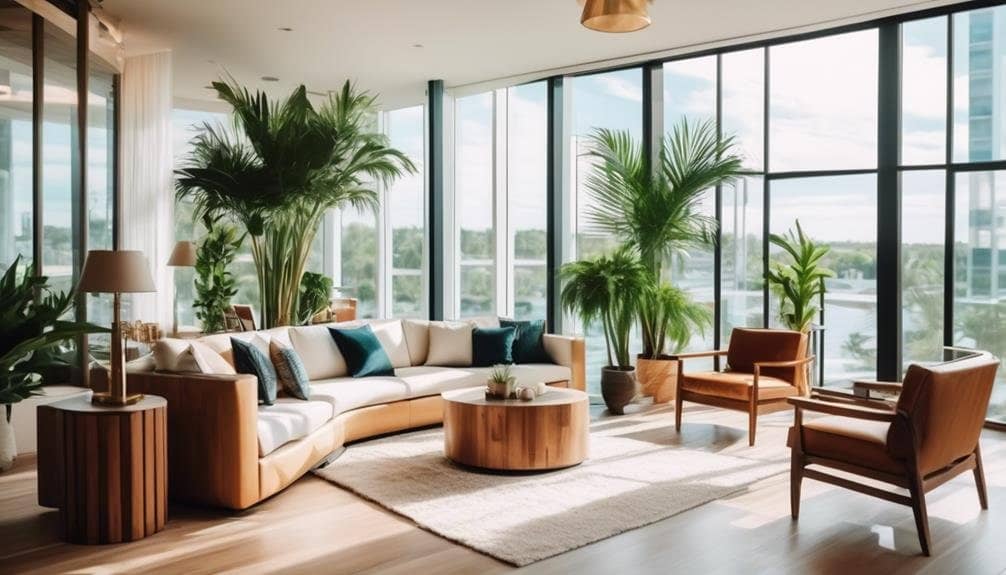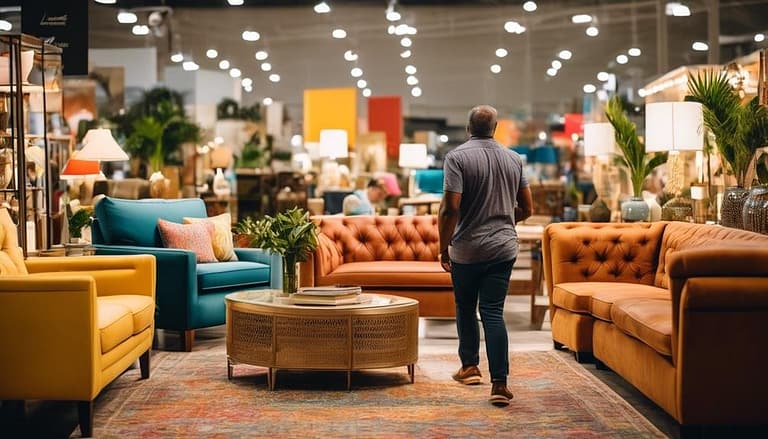The Role of Biophilic Design in Tampa Interiors

The role of biophilic design in Tampa interiors is significant. By integrating natural elements into interior spaces, it goes beyond just aesthetics. It has the power to positively impact your mood and productivity, evoking a sense of tranquility and contributing to overall well-being.
The deliberate incorporation of natural elements that seamlessly blend with the built environment achieves this. For example, incorporating natural light through large windows, using natural materials like wood and stone, and adding living plants can create a calming and refreshing atmosphere. These elements not only look beautiful but also have a remarkable effect on the ambiance of a space.
It's important to understand how biophilic design can transform interiors and improve the quality of our daily lives.
Key Takeaways
Biophilic design plays a crucial role in Tampa interiors. Integrating natural elements into interior spaces goes beyond just looks; it has the power to positively impact your mood and productivity, evoking a sense of calm and contributing to overall well-being.
Incorporating natural light through large windows, using materials like wood and stone, and adding living plants can create a calming and refreshing atmosphere. These elements not only look beautiful but also have a remarkable effect on the ambiance of a space.
Understanding how biophilic design can transform interiors and improve the quality of our daily lives is important. It's about creating a connection with nature within the built environment, enhancing our well-being and comfort.
The Benefits of Biophilic Design
The use of biophilic design can transform your interior spaces, creating a sense of calm and well-being while improving overall productivity and creativity.
By integrating elements of nature into your interior spaces, you can establish a strong connection with the natural world, promoting a healthier and more balanced environment. Natural features like plants and materials not only enhance the visual appeal but also improve air quality, contributing to a healthier indoor setting.
Maximizing natural lighting and adding indoor plants can significantly increase productivity and stimulate creativity within your interior spaces. This design approach goes beyond aesthetics; it aligns with a growing environmental consciousness, promoting sustainability and a deeper appreciation for nature.
The benefits of biophilic design also extend to mental well-being, reducing stress and creating a more tranquil atmosphere. Collaboration between designers, architects, and landscaping professionals to integrate biophilic elements results in an interior space that not only looks visually appealing but also contributes to a healthier and more productive lifestyle.
Incorporating Nature Indoors
Bringing nature indoors can significantly improve the atmosphere and overall well-being of your interior spaces. Embracing biophilic design in your interior can bring a sense of calm, reduce stress, and enhance the aesthetic appeal of your space. Consider adding natural elements like potted plants, indoor fountains, and aquariums to create a peaceful atmosphere. Using natural materials such as wood and stone adds a cozy and warm feel to your space while connecting it with nature. Maximizing natural lighting can help improve sleep patterns and productivity, reduce the need for artificial lighting, and enhance the overall atmosphere. Additionally, choosing natural colors and patterns inspired by nature can further enhance the biophilic experience and create a soothing ambiance. Here's a table illustrating the various elements that can be integrated into your interior spaces:
| Natural Elements | Benefits |
|---|---|
| Potted Plants | Serenity, air purification, stress reduction, aesthetics |
| Indoor Fountains | Tranquility, stress reduction, calming atmosphere |
| Natural Materials | Rustic charm, warmth, connection with nature |
| Natural Colors | Calming ambiance, enhanced biophilic experience |
Tampa's Biophilic Design Elements
In Tampa, incorporating biophilic design in interiors means using natural shapes, forms, and patterns to create a calming and visually appealing environment. The focus is on maximizing natural light and adding indoor greenery like living walls to bring nature indoors.
Considering factors such as prevailing breeze and natural ventilation is crucial in custom home design to seamlessly blend interior and exterior spaces. Alvarez Homes specializes in guiding homeowners in incorporating biophilic design principles to create safe, healthy, and inspired environments.
Biophilic design aims to enhance overall well-being by improving cognitive function, reducing stress, and lowering blood pressure through its seamless integration of natural elements. Water features, organic materials, and sustainable design practices further contribute to the embrace of biophilia, fostering a sense of freedom and connection with the natural world within Tampa's interior spaces.
Creating Wellness Through Design
Designing for wellness involves maximizing natural lighting, incorporating indoor plants, using biophilic materials, integrating water features, and choosing natural colors and patterns. These elements play a crucial role in creating a sense of well-being and fostering connections with nature, offering a reprieve from the fast-paced modern lifestyle. With a significant amount of time spent indoors, it's essential to prioritize natural elements in design to promote health and happiness.
Maximizing Natural Lighting: Enhancing mood and energy levels, creating a sense of spaciousness, and reducing reliance on artificial lighting are key benefits of maximizing natural lighting. It also contributes to a more sustainable and eco-friendly environment.
Incorporating Indoor Plants: Improving air quality, reducing stress, and adding a touch of nature and tranquility are some of the advantages of incorporating indoor plants. They also foster a connection with the natural world and promote a sense of harmony with the environment.
Using Biophilic Materials: Utilizing sustainable and eco-friendly materials, mimicking natural textures and patterns, and promoting a sense of harmony with the environment are important aspects of using biophilic materials.
Incorporating Water Features: Adding a calming and soothing element, enhancing the overall aesthetic appeal, and evoking the feeling of being outdoors are the benefits of incorporating water features.
Choosing Natural Colors and Patterns: Reflecting the beauty of the natural world and evoking the feeling of being outdoors are key aspects of choosing natural colors and patterns. They contribute to creating a serene and harmonious environment.
Enhancing Tampa Homes With Biophilia
Enhance your Tampa home with biophilic design elements to create a harmonious and inspired living space. Here are some simple yet effective ways to achieve this:
- Embrace the Florida sunshine by incorporating large windows and skylights to flood your home with natural light, creating a warm and inviting atmosphere.
- Connect with the natural environment by installing expansive floor-to-ceiling windows that offer breathtaking views of your surroundings and blur the line between indoor and outdoor spaces.
- Infuse your home with the soothing presence of nature by incorporating living walls and indoor plants, adding aesthetic appeal and contributing to improved air quality and overall well-being.
- Opt for natural materials such as wood, stone, and earth-toned paint colors to evoke a sense of the outdoors within your living space, creating a tranquil and grounding environment.
These design elements not only enhance the aesthetic appeal of your home but also contribute to a sense of well-being and connectedness to nature.
Frequently Asked Questions
What Is the Role of Biophilic Design?
Biophilic design aims to enhance cognitive function and reduce stress by incorporating natural elements, environmental features, natural shapes, and light into the design. This approach creates a safe, healthy, and inspiring environment tailored to your needs in home design. For example, integrating elements such as natural light and greenery can significantly improve the overall well-being of the occupants. By maximizing these natural elements, biophilic design contributes to a more comfortable and harmonious living space.
What Are the Benefits of Biophilia in Interior Design?
In interior design, incorporating biophilia brings natural elements into your space, improving well-being, reducing stress, and fostering a stronger connection to nature. This approach enhances air quality, boosts productivity, and creates a sense of calm and relaxation. For example, adding potted plants, natural materials, and nature-inspired artwork can effectively integrate biophilia into interior spaces. Transitioning to a biophilic design can make a noticeable difference in the overall atmosphere of a room. It's important to consider how these natural elements can be seamlessly integrated into the existing design to create a cohesive and harmonious environment. Making these changes can significantly impact the way people experience and interact with the space, ultimately contributing to a more inviting and rejuvenating atmosphere.
What Are the Three Pillars of Biophilic Design?
Biophilic design focuses on maximizing natural light, incorporating indoor plants, and using biophilic materials to bring nature into interior spaces. This approach enhances well-being and productivity by creating a harmonious and soothing environment. For instance, maximizing natural light can reduce the need for artificial lighting and create a more open and inviting space. Incorporating indoor plants not only adds a touch of nature but also improves air quality and reduces stress. Furthermore, using biophilic materials such as natural wood and stone can evoke a sense of connection to the natural world, promoting a sense of calm and tranquility. These elements work together to create a space that is both visually appealing and beneficial for overall well-being.
What Are the Implications of Biophilic Design?
Incorporating biophilic design into interiors can improve cognitive function, reduce stress, and enhance well-being. It's crucial for creating a harmonious living environment. Residents in luxury homes can experience numerous benefits from this approach. This design approach connects people with nature, leading to a more comfortable and calming living space. By incorporating natural elements like plants, natural light, and organic materials, it creates a soothing and rejuvenating atmosphere. In luxury homes, incorporating biophilic design can lead to a more tranquil and refreshing living experience. For example, integrating a living green wall or a small indoor garden can bring the serenity of nature indoors, promoting relaxation and mental clarity. Overall, biophilic design offers a practical and effective way to enhance the quality of life in luxury homes.






